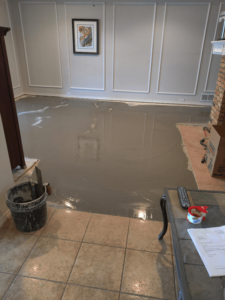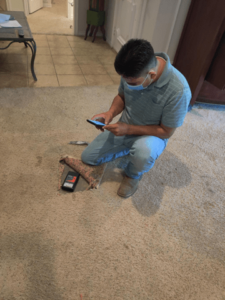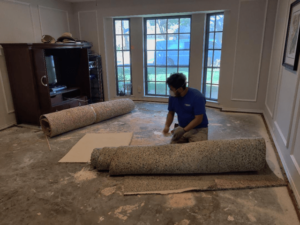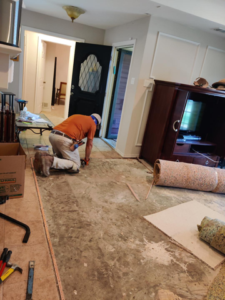We recently installed a laminate floor in a Richardson home that was about 40 years old. The homeowners were anxious to get it installed, but we were cautious.
The living room had a one-inch crack in the ceiling and a patch of mold on the wall. Many walls showed peeling tape and cracks. A seven-inch span of baseboard showed deterioration. In one of the bedrooms, the foundation was wet.
Installation under these circumstances promised trouble down the road. We couldn’t warranty the job before we addressed these issues. Then postponed installation pending identification of the causes.
We applied a pre-installation checklist for laminate floors in the form of five questions.
1. ARE THERE CRACKS IN THE WALLS?
Cracks in walls often indicate foundation issues, especially if they are diagonal or near doorways. [At the job site, an engineer assessed the property. He found no foundation issues. The age of the drywall tape and bed and the fragility of the recessed ceiling caused the cracks. A handyman accomplished repairs.]
2. IS THERE A WATER LEAK?
Mold on walls or rotted woodwork, such as baseboards, suggests that water is leaking. [We found that the front window in the living room had exterior damage and needed repair. Water had seeped into the living room and deteriorated the baseboard. Gutters also needed to be cleaned to direct water flow away from the building.]
3. DO PLUMBING PARTS NEED TO BE REPLACED?
Plumbing failure can ruin the laminate floor and everything else in a house. The number one cause for plumbing floods is old valves. Valves under sinks and toilets can fail after five years, depending on water chemistry. Has the plumbing (especially valves) been checked before you install your new floor?
4. IS THE FOUNDATION SOUND?
In every room, the foundation should be checked with a moisture meter prior to installation. Water can damage any laminate floor, causing cupping and curling, mold, and early deterioration. [In the Richardson house, we found a hose bib leak that caused the floor to be damp. This was a quick fix.]
5. IS THE FOUNDATION FLAT?
Laminate components do not bend, but almost every foundation has dips, valleys, and peaks. The underlying surface must be smooth and flat prior to installation. We use Float, a cement-like leveling material, to resolve variations. There is no way to know how much Float is needed until the old flooring is removed and the foundation is assessed.
An experienced flooring professional assesses multiple aspects of a residence to accomplish a successful installation. A holistic examination of your home before an installation will ensure that your investment yields a floor that’s attractive, silent, and durable.






